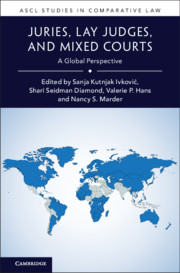Book contents
- ASCL Studies In Comparative Law
- Juries, Lay Judges, and Mixed Courts
- Copyright page
- Contents
- Editors
- Contributors
- Acknowledgments
- 1 Introduction
- Part I Advances in Lay Participation
- Part II Enduring Systems of Lay Participation
- 7 “… And My Right”
- 8 “In the Name of the People”
- 9 The Jury in Canada
- Part III Challenges to Lay Participation in Law
- Part IV Global Perspectives on Lay Participation
- Name Index
- Subject Index
- References
7 - “… And My Right”
The Magistrates’ Courts in England and Wales
from Part II - Enduring Systems of Lay Participation
Published online by Cambridge University Press: 03 August 2021
- ASCL Studies In Comparative Law
- Juries, Lay Judges, and Mixed Courts
- Copyright page
- Contents
- Editors
- Contributors
- Acknowledgments
- 1 Introduction
- Part I Advances in Lay Participation
- Part II Enduring Systems of Lay Participation
- 7 “… And My Right”
- 8 “In the Name of the People”
- 9 The Jury in Canada
- Part III Challenges to Lay Participation in Law
- Part IV Global Perspectives on Lay Participation
- Name Index
- Subject Index
- References
Summary
Lay magistrates are involved in most of the criminal cases in England and Wales. They typically sit in panels, but in minor cases they sit as single decision-makers. In both situations, they are assisted by a legal adviser. Lay magistrates also hear appeals as part of a mixed court presided over by a professional judge. Lay magistrates are more diverse in personal characteristics than professional judges, but the level of commitment required results in an overrepresentation of older, middle-class people. The lay magistrate is defined by law, professional work patterns, budget constraints, and the traditional legal culture. In addition, the architecture of the courtroom, as well as the use of video links, often impedes interaction between lay magistrates and defendants. These constraints at times threaten justice and procedural fairness. The number of lay magistrates has been declining for years. To dispose of cases more quickly, professional judges have taken a slice of the caseload. A different work pattern can be found at the youth court where magistrates engage actively with the defendant and are not confined to a narrow decision-making function.
Keywords
- Type
- Chapter
- Information
- Juries, Lay Judges, and Mixed CourtsA Global Perspective, pp. 131 - 151Publisher: Cambridge University PressPrint publication year: 2021



